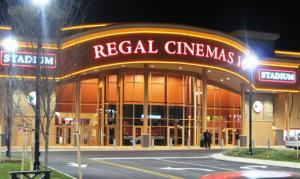Do you remember The Majestic? It’s that Jim Carrey movie made by a post-Green Mile, pre-Walking Dead Frank Darabont. It was actually Darabont’s first film not adapted from a Stephen King story, trading out the prison tales of Shawshank Redemption and Green Mile for a Capra-esque 1950s tale of an amnesia-stricken Hollywood screenwriter (Jim Carrey) washing up to shore in a small town where he’s mistaken for a long lost WWII hero. The title refers to the town’s run-down movie theater managed by Martin Landau, and at one point he delivers a wistful speech about a pre-TV world in which films were a communal experience which everyone engaged in, feeling privileged to watch gods of cinema like Keaton, Lloyd, Garbo, Gable, Lombard, Stewart, and Cagney. The films themselves were good, but seeing them together as a community made them great. So, who the hell was TV to come along, and tie all of us to a silly little box in our living room!
Well, those “boxes in the living room” are now attached to our wrists, forever in our pockets via smart phones, never too far out-of-reach via tablets, etc. If TV once almost killed film mobile entertainment is now killing both film and TV. How we even define what constitutes TV is ever-shifting, with actress Gillian Jacobs recently having to cut herself off in an Entertainment Weekly interview in which she was about to refer to her now-revived Community as a TV show (which is what it used to be on NBC), quickly realizing it would be more accurately called “content” now (which is what it will be for online streaming entity Yahoo Screen). Even video game companies are getting into the “content” business now, Xbox with its much-delayed Halo series and Sony Playstation with its adaptation of the Powers comic book series.

Dang you, Sony!
That must sting a little for both film and TV because video games are killing them right now. According to the Entertainment Software Association, the video game industry, including computer, console, and mobile games as well as video game systems, cracked $20 billion ($20.77) in U.S. sales in 2012. Compare that to the film industry which just set a record last year in annual domestic box office, $10.92 billion. Keep in mind that when we say “domestic box office” we mean the U.S., Canada, Puerto Rico, and Guam meaning it’s not even an exact comparison since at the very least those U.S. video game sales don’t include Canada, which is the third leading video game industry in the world.
Of course, a deeper dive into the data reveals troubling trends. On the video game side of things, the actual sales of console (Playstation, Xbox, Nintendo) games have been tanking, going from $9.9 billion in 2010 to just $6.1 billion in 2013. On the film side, revenue has managed to make incremental progress in the past couple of years mostly due to rising ticket prices. Actual film attendance is down, with 1.24 billion tickets expected to be sold in 2014, down from the 1.34 billion in 2013 and 1.36 billion in 2012. Fewer people are going to the movies the same way fewer people are actually buying Playstation and Xbox games, with the real growth actually coming from online content and mobile gaming. So, if you make video games you start diverting more of your resources toward the mobile market, and if you make film and TV content you adapt to a world increasingly speaking the language of on-demand and Netflix.
Where does that leave movie theaters, though? Attendance is down, and while that was masked in annual revenue the past couple of years the same won’t be said for 2014, which will end up as the worst year for movies since 2011. Movie theaters make their real money from concession sales – there’s a reason their popcorn is so overpriced! However, if fewer people are showing up that means fewer boxes of candy and oversized cups of Coke being sold which ultimately means fewer movie theaters, with the number of theaters in the United States declining every year since 2009. To be fair, part of that has nothing to do with attendance and everything to do with inability to afford the transition from film to digital projection. Plus, while there are fewer theaters there are actually more movie screens, over 39,000 in the country, than ever before. However, for the past couple of years there have been fewer and fewer people enjoying those 39,000 movie screens.
Some theaters are trying to be proactive about this. Here are a couple of the ways they’re trying to rejuvenate movie attendance:
1. AMC Movie Pass 
MoviePass has been around, at least in concept, for a couple of years now, most commonly described as “Netflix for Movie Theaters.” They sell you a monthly subscription in exchange for unlimited theatrical screenings, but for that to work you kind of need the movie theaters to cooperate. That hasn’t really happened, but AMC Theaters, the second leading theater chain in North America, is now willing to at least give it a try. Beginning in January, they are partnering with MoviePass to beta-test the concept in Boston and Denver. The monthly subscription packages will be tiered at $45, including normal films as well as Imax and 3-D, and $35 for all non-Imax and 3-D screenings. The idea is clearly that if you pay the monthly fee you will be inclined to see more to get the most out of your money. At the current average ticket price of $8.12, the lower tiered MoviePass is the equivalent of 4 individual ticket purchases, but you could see as many as you wanted. You might be screwed if you had this MoviePass for a down month for new movies, like January, which is, of course, exactly when they have decided to test this out. However, that’s probably the only way they could get the studios to agree to it. I’d personally kill to have this kind of option at my local theater over the summer and throughout November and December, but I run a movie blog. Of course I see a ton of movies every year! The average American only sees 5 movies in theaters a year, with 18-36-year-olds being on the high end (6.3 movies a year) and those in the senior circuit (68+) on the low end (3.8 movies a year). You have to wonder if there are truly enough statistical outliers like me to turn AMC Movie Pass into a success? It’s worth finding out, though. From a box office tracking standpoint, I do wonder how these passes would count toward each individual film’s box office and number of tickets sold.
2. Loyalty Programs

3. Discount Movie Days

Suck it, poor people! We don’t want the crappy demeanor inherent to your low economic standing to ruin our theaters! I kid, I kid, but, seriously, there is actually some validity to this argument. Without fail, the worst audiences I’ve ever encountered while attending movies happened at the one theater in town which offered heavy discounts to teenagers, college students, and senior citizens (I went there because I was a college student, and that discount kicked ass). Of course, if you make it a point among your staff to curb rude behavior you can deal with that.
4. Theater Exclusivity

5. Tugg

–

However, you’d rather not simply wait for business to hopefully rebound when a better set of movies come along, especially since audiences may yet turn on sequels, reboots, and comic book movies. Some theaters are starting to think outside the box, and some of their ideas are kind of awesome, others more wait-and-see. I’d personally love to sign up for Movie Pass right now. What about you? Are there any awesome local promotions with the theaters in your neck of the woods? Let me know in the comments.
Sources: Collider, FilmSchoolRejects, Vulture

